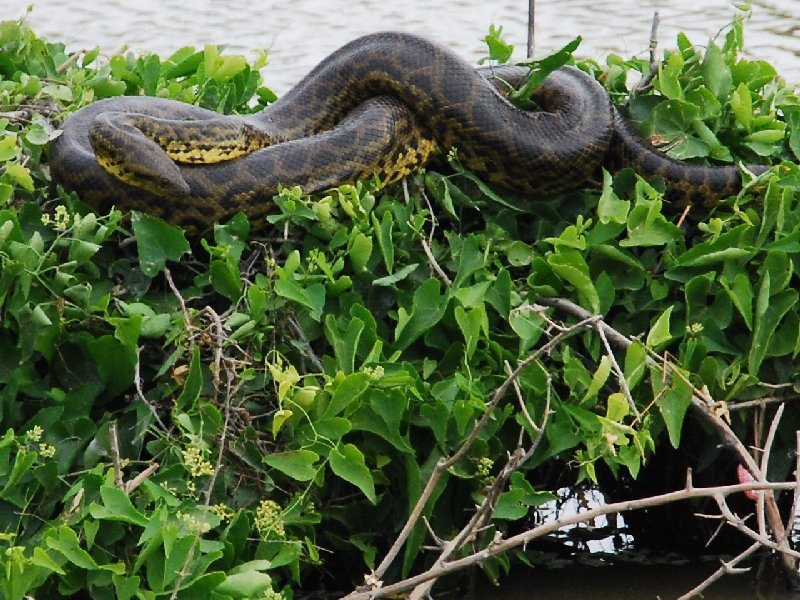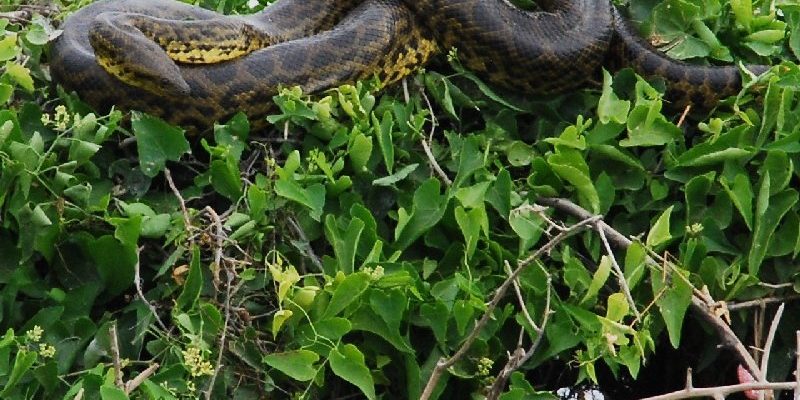
Imagine a snake that can grow as long as a small car. That’s the Yellow Anaconda for you! This incredible creature, known for its impressive size and strength, is one of the largest snakes in the world. Found primarily in the lush wetlands of South America, particularly in countries like Brazil, Paraguay, and Argentina, the Yellow Anaconda is not just big; it’s fascinating. It glides through the water with ease and can often be spotted basking in the sun, showcasing its uniquely beautiful yellow and black pattern.
What makes the Yellow Anaconda truly remarkable is not just its size, but also its hunting prowess. It is a non-venomous constrictor, which means it kills its prey by wrapping around it and squeezing until it suffocates. So, whether you’re a snake enthusiast or just curious about this large reptile, let’s explore the life, habitat, diet, and more about the Yellow Anaconda.
Physical Characteristics
The Yellow Anaconda is a sight to behold. Adults can reach lengths of up to 15 feet, although some reports claim they may grow even longer. Their bodies are thick and muscular, allowing them to catch and overpower large prey. The distinctive color pattern plays a crucial role in their camouflage, helping them blend in with their environment, especially in the murky waters and dense vegetation of the swamps.
Aside from length, one fascinating aspect of the Yellow Anaconda is its weight. These snakes can weigh over 100 pounds! This hefty mass is mainly due to their powerful muscles and massive girth, which is essential for constricting their prey. The skin features bold yellow and black markings that not only serve to ward off potential threats but also make them a beautiful sight in their natural habitat.
| Length: | Up to 15 feet |
| Weight: | Over 100 pounds |
| Diet: | Fish, birds, mammals |
| Habitat: | Swamps, marshes |
| Lifespan: | 10-15 years in the wild |
| Speed: | Up to 1 mph in water |
Habitat and Distribution
Yellow Anacondas thrive in watery environments, making wetlands, swamps, and marshes their home. They prefer slow-moving waters or the floodplains of rivers, where they can easily navigate and hunt. The dense foliage offers them ample opportunities to hide, whether they’re waiting for prey or sunbathing. It’s like living in a cozy waterbed surrounded by lush greenery!
These snakes are predominantly found in the northern parts of South America, particularly in countries like Brazil, Colombia, and Venezuela. They’re often associated with the Amazon rainforest, where the climate is warm and humid—ideal conditions for these reptiles. The combination of water and vegetation gives them the perfect spot to thrive, showcasing their incredible adaptability.
Diet and Hunting Behaviors
When it comes to dining, the Yellow Anaconda is anything but picky. It feeds on a diverse diet that includes fish, birds, and even larger mammals like capybaras. The hunting method of the anaconda is both fascinating and efficient. It will often lie in wait, camouflaged by the surrounding environment, before launching a surprise attack. With a swift movement, it grabs its prey and wraps around it, suffocating it before swallowing it whole. Can you imagine how it feels to catch such a meal? It’s a powerful display of nature.
You might be wondering if they hunt in water or on land. The answer is both! Yellow Anacondas are excellent swimmers, allowing them to sneak up on unsuspecting prey from below the surface. When hunting on land, they rely on their strength and stealth, waiting for the perfect moment to strike. Their ability to adapt to different hunting environments makes them successful predators in their habitat.
Behavior and Social Structure
Despite being solitary creatures, Yellow Anacondas can exhibit interesting behaviors, especially during mating seasons. Males often engage in a phenomenon known as the breeding ball, where several males compete to mate with a female. This can lead to quite a spectacle, as multiple snakes intertwine in a writhing mass. It’s nature’s version of a dance-off!
Generally, these snakes tend to be more active at night, which is when they hunt and mate. During the day, you might find them basking in the sun or resting in the water. This daily rhythm helps them regulate their body temperature. Interestingly, Yellow Anacondas are known for their ability to remain submerged for extended periods, which allows them to avoid predators and surprise their prey.
Conservation Status
While the Yellow Anaconda is currently listed as a species of “Least Concern,” it faces several threats in its natural habitat. Habitat destruction due to agriculture and urbanization poses a significant risk to their populations. Additionally, hunting for their skin threatens their numbers, as their beautiful patterns make them appealing in the exotic pet trade.
Conservation efforts are essential to ensure that these majestic creatures continue to thrive. Protecting their natural habitats and raising awareness about their ecological significance can help maintain the delicate balance of their ecosystem. After all, every species plays a role in its environment, and the loss of one could have ripple effects that impact many others.
Interesting Facts About Yellow Anacondas
Yellow Anacondas are not just impressive because of their size; they come with a host of fascinating features. For instance, they are one of the few snake species known to give live birth! Rather than laying eggs, female anacondas can give birth to dozens of live young, making them unique among snakes. Imagine the sight of all those tiny anacondas slithering into the world!
Another interesting fact is their incredible strength. Yellow Anacondas have been recorded squeezing their prey with a force of up to 90 psi (pounds per square inch), which is more than enough to crush bones. This extraordinary power is essential for subduing large animals, and it showcases the muscle-packed nature of these reptiles.
FAQ
Where can I find Yellow Anacondas in the wild?
Yellow Anacondas are primarily found in the wetlands, swamps, and marshes of South America. Countries like Brazil, Venezuela, and Paraguay are home to these majestic snakes. They prefer slow-moving waters and dense vegetation for both hunting and basking.
Are Yellow Anacondas dangerous to humans?
While Yellow Anacondas are large and powerful, they are generally not a threat to humans. They are non-venomous and tend to avoid human contact. However, if provoked, they can defend themselves, so it’s best to admire them from a distance!
What do Yellow Anacondas eat?
Yellow Anacondas have a varied diet that includes fish, birds, and mammals. They are skilled hunters, using their stealth and strength to capture prey, often suffocating it before consumption. Their ability to take down larger animals makes them formidable predators.
How long do Yellow Anacondas live?
In the wild, Yellow Anacondas can live anywhere from 10 to 15 years. Factors such as habitat quality, availability of food, and threats from predators can affect their lifespan.
Can Yellow Anacondas swim?
Absolutely! Yellow Anacondas are excellent swimmers. Their muscular bodies enable them to glide smoothly through the water, allowing them to hunt and evade threats effectively. They can hold their breath for extended periods while submerged.
How do Yellow Anacondas reproduce?
Unlike many other snakes that lay eggs, Yellow Anacondas give live birth. After a gestation period of around six months, a female can produce anywhere from 20 to 80 live young, depending on her size and health. This unique reproduction method is quite fascinating!
Are Yellow Anacondas kept as pets?
While some people do keep Yellow Anacondas as pets, it’s important to note that they require specialized care and a spacious environment due to their size. Potential owners should do thorough research and be prepared for the responsibilities of caring for such a large snake.
What threats do Yellow Anacondas face?
Yellow Anacondas face threats from habitat destruction and poaching. Urban development and agricultural expansion reduce their natural habitats, while illegal hunting for their skin can threaten their populations. Conservation efforts are crucial for their survival.
How do Yellow Anacondas hunt?
Yellow Anacondas are ambush predators. They often lie in wait, camouflaged in their surroundings, before striking at their prey. Their ability to swim and navigate both land and water enhances their hunting effectiveness, allowing them to catch a variety of animals.
What adaptations do Yellow Anacondas have for their environment?
Their color pattern aids in camouflage, helping them blend into the lush vegetation and water. Additionally, their muscular bodies allow them to exert significant force when constricting prey. They also have the ability to regulate their body temperature by basking in the sun or remaining submerged in cool waters.
Do Yellow Anacondas have natural predators?
Yes, young Yellow Anacondas are particularly vulnerable to predators such as birds of prey, larger snakes, and even caimans. However, adult Yellow Anacondas have few natural predators due to their size and strength.
Can Yellow Anacondas be found in zoos?
Many zoos feature Yellow Anacondas in their reptile exhibits, allowing visitors to learn about these fascinating creatures. They serve as ambassadors for their species, promoting awareness and conservation efforts.

